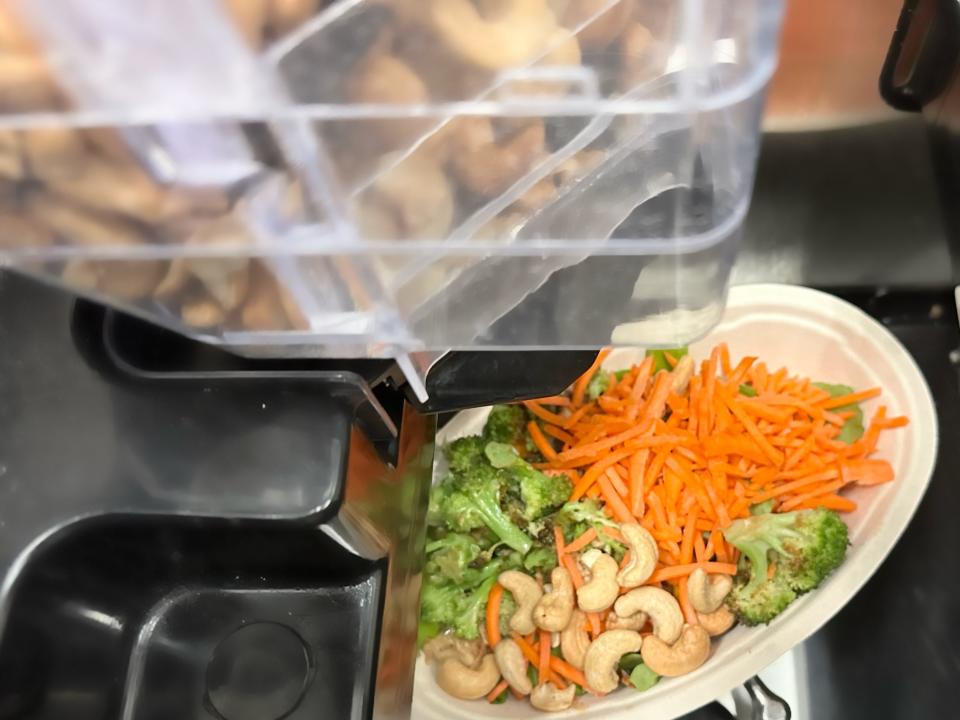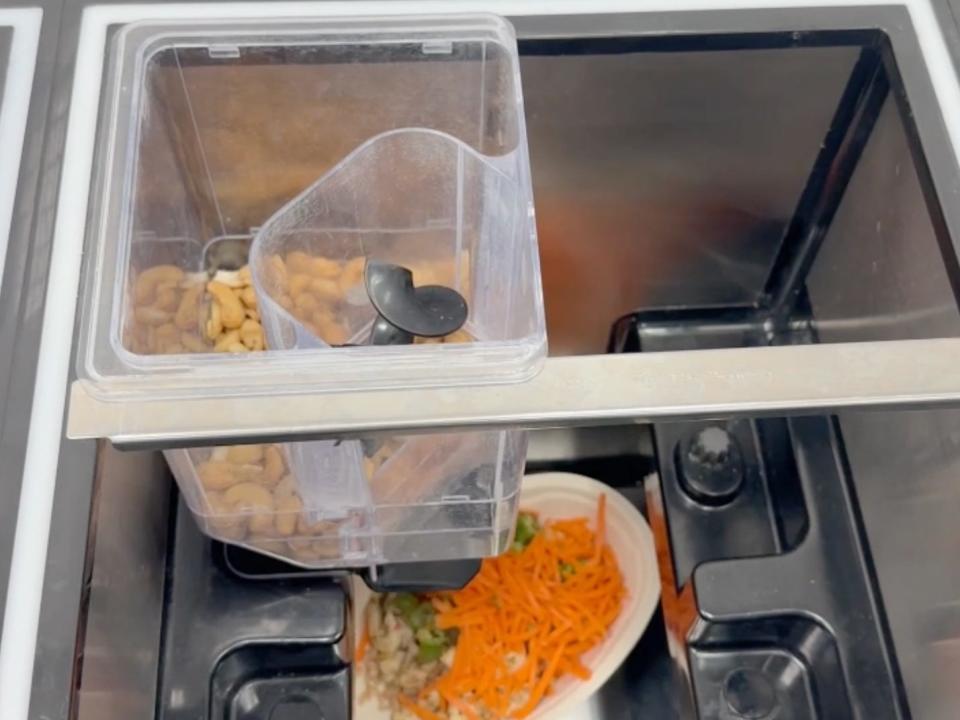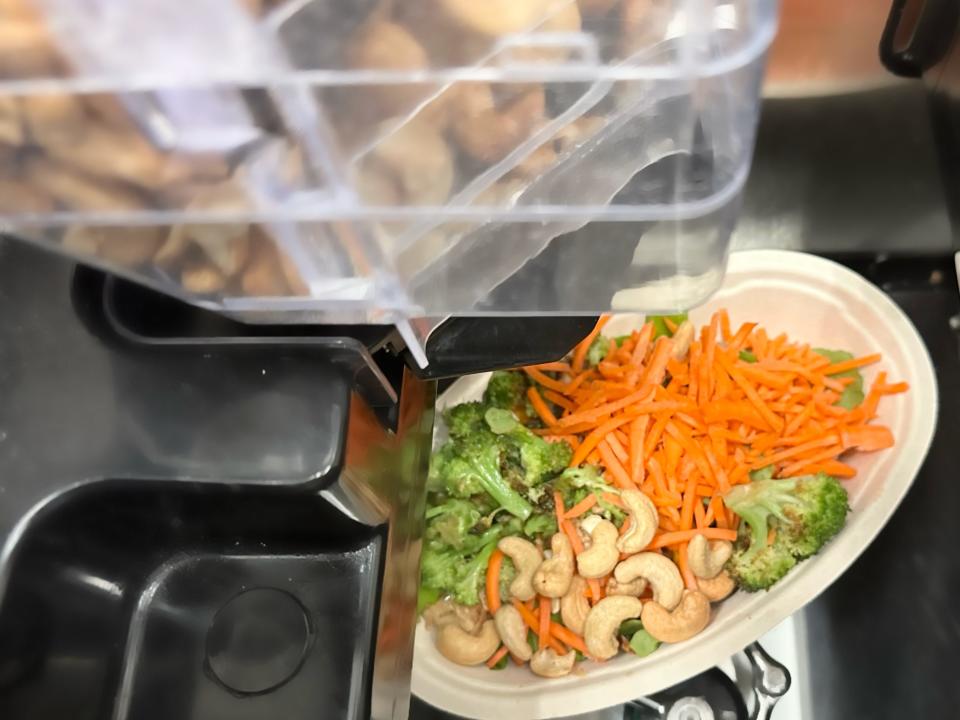See Chipotle's new robots that can crank out nearly 200 burrito bowls an hour

Restaurant chains are relying on automation to streamline operations and save on labor.
Chipotle is working with Hyphen, a startup that uses robotics to make up to 180 bowls per hour.
Insider got an exclusive look at Hyphen's bowl-making robotics. Here's how it works.
Restaurants challenged by labor costs and retention are automating every part of the business. Chick-fil-A is testing robot bussers. McDonald's, Domino's, and White Castle use AI-powered voice bots to take drive-thru-and phone orders.
Now, a robot could soon be making your next Chipotle burrito bowl.
The chain is testing an automated kitchen line by Hyphen to prepare digital orders, a $3 billion business for Chipotle.
Hyphen is one of a dozen food tech startups in the industry looking to streamline food operations for restaurants through the use of robotics and automation. But unlike other tech firms, Hyphen has buy-in from Chipotle, one of the industry's most innovative brands. Chipotle invested in Hyphen in 2022 and started piloting its robotics this year in a lab near the chain's Newport Beach, California, headquarters.
In an April earnings call, CEO Brian Niccol called the technology an exciting part of the chain's future as it strives to reach 7,000 restaurants.
Hyphen "will enable us to be even more accurate," Niccol said. "I think probably go a little bit faster, and I think give people more consistent experiences."
In July, Niccol told investors that Chipotle expects to install Hyphen's automated kitchen line in restaurants "in the next 12 to 18 months."
Based in San Jose, California, Hyphen recently gave Insider an exclusive first look at how it uses robotics to make up to 180 bowls per hour. That's about six times more than what a human can assemble in the same time.
Here's how it works.
In July 2022, Chipotle's Cultivate Next venture fund invested in Hyphen, a Silicon Valley tech startup building kitchen automation tools.

Hyphen's The Makeline uses advanced robotics to assemble meals such as grain bowls and salads.
Chipotle and Hyphen started testing the system this year at the chain's test lab in Newport Beach, California.
The Makeline doesn't require humans to prepare bowls. But that's not Chipotle's main interest in Hyphen, the company has said.
Hyphen's tech will help the chain improve speed and order accuracy of digital orders, Curt Garner, Chipotle's chief technology officer, has previously said.
"Their use of robotics to enhance the employee and guest experience to find efficiencies in the restaurant industry aligns with our mission of leveraging emerging technology to increase access to real food," Garner said of Hyphen.
During my exclusive video demo, Hyphen showed me how a grain bowl is made using its robotics system.

Once an order is placed, it is automatically sent to Hyphen's The Makeline. Metal arms move bowls from one food dispenser to another as they fill each bowl with ingredients.
A metal arm at the bottom of the production system moves the bowl to a pan that holds grains and squash.

The farro and squash are sent down a chute to fill the bowl. Once complete, the metal arms move the bowl automatically down the assembly line.
Hyphen's The Makeline is designed to automate any assembly-line food operation that makes bowls or salads like CAVA, Chipotle, or Sweetgreen.

While it doesn't make burritos, Hyphen's Makeline can help "build" burritos by dispensing ingredients through its automated system, cofounder and chief technology officer Daniel Fukuba told Insider during a recent interview.
Then, an employee could take those ingredients and fold them into a tortilla, he said.
The Makeline is also designed with open bins so employees can work in tandem with the system if needed.
Metal arms beneath the food pans move bowls from one food dispenser to another.

The farro and squash are sent down a chute to fill the bowl. Once done, the metal arms move the bowl down the line.
In the testing phase, Hyphen makes bins and augers, spiral-shaped tools, from 3D printers.

Some of the equipment used to hold food are made using 3D printers. Augers, or spiral-shaped tools, are also made with 3D printers.
Fukuba said Hyphen is using 3D printers to make production tools only during the research and development phase. The 3D printers allow the startup to test new designs in a timely manner as they perfect the assembly-line process.
"We have three printers working 24/7," he said. "Speed is essential as a startup."
The next stop on the line is toppings. Roasted and salted cashews top the bowl. Portioning is automated using algorithms based on the order size.

Fukuba said The Makeline is programmed to dynamically portion ingredients based on the order size.
"Algorithms dynamically adjust to the order size," he said.
The Makeline will "scale up" each item if the customer chooses only a few toppings. But if someone orders a lot of add-ons, the system will reduce each portion size to ensure everything fits in the bowl. Protein portions are never reduced, Fukuba said.
Dynamic portioning means chains like Chipotle can deliver a consistent meal every time. Fukuba said it solves issues restaurants have with customers complaining they've received "under portioned" meals.
The bowl continues down the Makeline until all the ingredients are prepared. The Makeline can crank out between 120 to 180 bowls per hour depending on the number of ingredients on the menu.

How does automation compare to a human?
Hyphen said one person can make about 20 to 30 bowls per hour.
Besides volume, chains like Chipotle can count on Hyphen's automation to be more accurate than a human.
"So generally, across the board, we're always more accurate than a comparable person running at the same rate," Fukuba said. "It is more consistent and accurate than a person normally would be going at the same speed."
A tablet at the end of The Makeline shows the progress of the bowl as it goes down the line. The tablet will indicate when an order is complete.

Once the bowl is completed, it is put in a lift and sent to the top of the Makeline. At that point, a human steps in. A worker then grabs the bowl, puts a lid on it, and gets it ready for pickup.
Chipotle is tapping Hyphen to help streamline its digital orders, which surpassed $3 billion in sales last year.

Since Brian Niccol became CEO in 2018, the chain has been focused on building its digital business.
Mobile orders can be picked up using Chipotle's drive-thru lanes, dubbed Chipotlanes. Restaurants also have pickup shelves for delivery and takeout orders made through the chain's app or third-party delivery services like DoorDash.
The chain is also testing new store designs, focusing solely on digital orders.
In 2022, Chipotle's digital business surpassed $3 billion in revenue. In the third quarter of 2023, digital sales represented 38% of the chain's food and beverage revenue.
Automating the preparation of digital orders is among a handful of tech initiatives Chipotle is piloting. The chain is also testing Chippy, a robotic tortilla-chip maker.

Chipotle's Chippy uses artificial intelligence to replicate Chipotle's exact chip-making recipe, the company said. Chippy is a one-store test for now.
The chain is also testing internally an avocado-cutting robot named Autocado. The robot is expected to slice guacamole preparation time in half. It's set to eventually use artificial intelligence and machine learning to evaluate the quality of the avocados to help limit waste.
Hyphen's The Makeline is expected to enter Chipotle restaurants next year.

Niccol said earlier this year that the chain will likely install the first automated makelines in new restaurants.
Hyphen and Chipotle are working to design the robotic makeline so it will "work with our existing restaurants," Niccol said.
The chain, which operates more than 3,250 restaurants, plans to more than double in size over time to 7,000 restaurants.
Read the original article on Business Insider

 money
money 